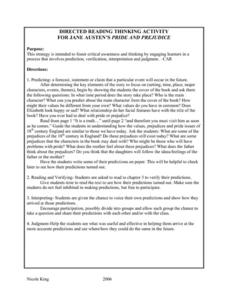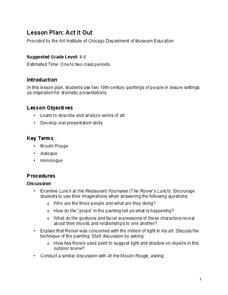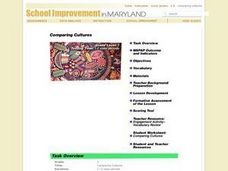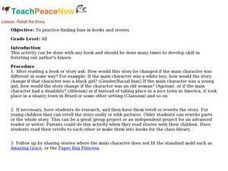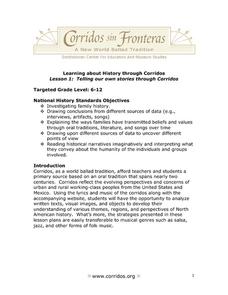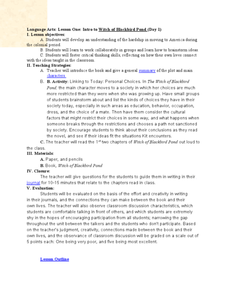Curated OER
Pride and Prejudice: Directed Reading Thinking Activity
Can you judge a book by its cover? Decide who and what Jane Austen's Pride and Prejudice is about with a prediction activity. Before reading the first three chapters of the book, kids answer questions based on their interpretation of the...
Curated OER
The Faithful Friend
Students work in co-op groups to create a Reader's Theater production of the story. Students create a flow map that sequences the major events in the story. Students research the island of Martinique and create a travel brochure...
Curated OER
Fairy Tales Retold
Students use writing processes effectively to adapt and retell stories. They reread a favorite fairy tale, then adapt and retell in a PowerPoint or other multimedia presentation. They present their rewritten and edited presentations to...
Art Institute of Chicago
Act It Out
Examine two works of art and use these pieces as inspiration for dialogues. The whole class discusses Renoir's Lunch at the Restaurant Fournaise and Toulouse-Lautrec's At the Moulin Rouge. Then, in groups of either three or ten, pupils...
Curated OER
Comparing Cultures
Young readers compare two stories/cultures, identifying how they are alike and different. They share their own version of a well-known story and adapt it to another culture. They explain their adaptations.
Curated OER
Comprehending Through Questioning
Elementary schoolers observe and apply a variety of reading comprehension strategies. They silently read a passage out of their science textbook, and discuss answering the who, what, where, when, and how of the text. In small groups they...
Curated OER
The Metamorphosis by Franz Kafka
Students, after reading and discussing, "The Metamorphosis," by Franz Kafka, explain the symbolism of Gregor's metamorphosis moving beyond a literal view of "he turned into a bug" into the idea that society/family/stress/environment led...
Curated OER
Who/Whom Usage Practice
In this who and whom practice worksheet, students read an informative lesson. Students then respond to 10 questions that require them to use who and whom appropriately.
Curated OER
Who / Whom Practice
In this nominative and objective pronouns worksheet, students read the rules for using "who" and "whom". Students read ten sentences and indicate which word is correct for each.
National Center for Case Study Teaching in Science
A Rose By Any Other Name
In part one, your astronomers read an interview dialogue between a reporter and Dr. Maria Ocasio, the chair of the group that assigns names to celestial objects. The topic in question is Pluto's status. Learners research Plutinos and...
Curated OER
Parables Extension Worksheet: the Sower and the Two Builders
For this parables worksheet, students retell the parable of The Sower and The Two Builders, write their own parable, draw pictures, and more. Students complete 7 activities.
Curated OER
Retell the Story
Young scholars identify bias in books. In this character education lesson, students read a text and discuss any gender or racial bias which may be present. Young scholars retell and rewrite the story in a fair way.
Alabama Learning Exchange (ALEX)
Whales, Whales, Whales!
The title says it all! Help your pupils learn all about whales. Class members research different species of whales and share the information via video conferences with kids from another school. They conduct research on a selected species...
Curated OER
Passing Down Family History Through Oral Tradition: Corridos
Students create and perform Corridos which are oral tradition ballads. In this Passing Down Family History Through Oral Tradition instructional activity, students interview family members using a predetermined list of questions. In...
Curated OER
Charlotte's Web
Fourth graders focus on fluency by reading the book Charlotte's Web. In this reading strategies lesson plan, 4th graders partner read, do guided reading, and independent reading to increase fluency. Students use Venn Diagrams, discuss...
Curated OER
Intro to Witch on Blackbird Pond
Fourth graders read Witch on Blackbird Pond and understand the difficulties of traveling to America during the colonial period. In this Witch on Blackbird Pond lesson, 4th graders compare the choices we have in traveling to America...
Curated OER
Rules
Students read about an autistic boy and learn about how he communicates. In this picture book summary lesson, students draw illustrations of events in the story that convey the theme.
Curated OER
Walk a day in my moccasins
Students create videos about students in their classroom. In this self-expression lesson, students use videos to give voice to students who are reluctant or can't participate. Students listen to several books and generate questions about...
Curated OER
Graphs, Stories, And Games
In this graphs lesson, students read stories and present story situations on a graph. They explore distance and diameter and explain graphs. Students create their own stories to fit graphs.
Curated OER
Cause And Effect
Fourth graders read the book Stellaluna and cite sentences that show cause and effect in the story. In this cause and effect lesson plan, 4th graders also write sentences that show cause and effect in their own lives.
Curated OER
Cinderella Stories
Students read and compare Cinderella stories using a worksheet. They write and illustrate original tales with a twist.
Curated OER
Language Arts: Plotting Stories
Second graders read the story, "The Foolish, Timid Rabbit," as part of a unit on appearances. After reading with partners, they write their own stories that include elements about some forms of matter from their science studies. Students...
Curated OER
Using Words to Work Things Out
Students recognize a problem and how to resolve it. In this lesson, students listen to The Hating Book and discuss the events of the story. Students answer comprehension questions and relate to their own experiences. Students role play...
Curated OER
Urban Legends
Students consider how people of color and minority culture are represented in video games. After debating the issue as representatives of various interest groups, students reflect on their personal feelings regarding this issue.


